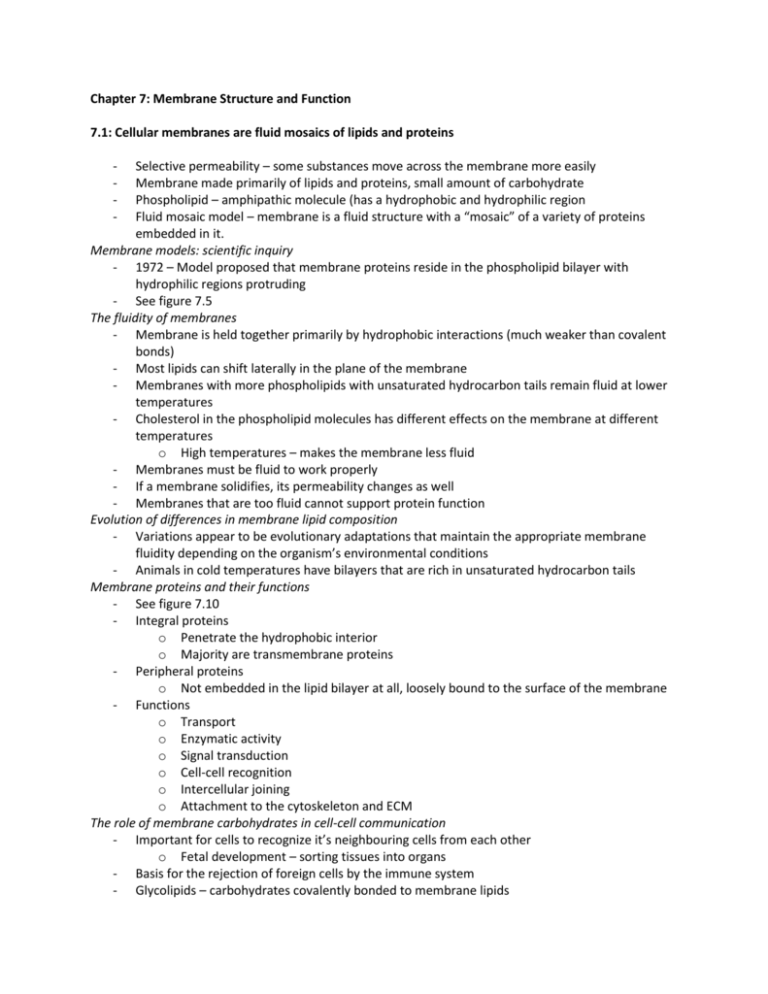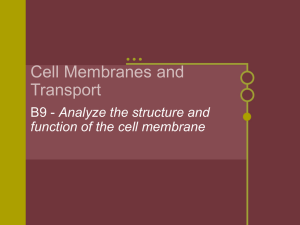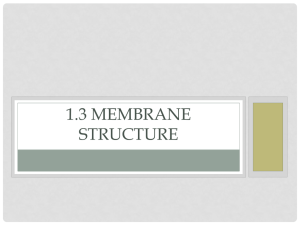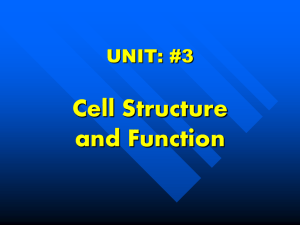Chapter 7 AP Bio
advertisement

Chapter 7: Membrane Structure and Function 7.1: Cellular membranes are fluid mosaics of lipids and proteins - Selective permeability – some substances move across the membrane more easily Membrane made primarily of lipids and proteins, small amount of carbohydrate Phospholipid – amphipathic molecule (has a hydrophobic and hydrophilic region Fluid mosaic model – membrane is a fluid structure with a “mosaic” of a variety of proteins embedded in it. Membrane models: scientific inquiry - 1972 – Model proposed that membrane proteins reside in the phospholipid bilayer with hydrophilic regions protruding - See figure 7.5 The fluidity of membranes - Membrane is held together primarily by hydrophobic interactions (much weaker than covalent bonds) - Most lipids can shift laterally in the plane of the membrane - Membranes with more phospholipids with unsaturated hydrocarbon tails remain fluid at lower temperatures - Cholesterol in the phospholipid molecules has different effects on the membrane at different temperatures o High temperatures – makes the membrane less fluid - Membranes must be fluid to work properly - If a membrane solidifies, its permeability changes as well - Membranes that are too fluid cannot support protein function Evolution of differences in membrane lipid composition - Variations appear to be evolutionary adaptations that maintain the appropriate membrane fluidity depending on the organism’s environmental conditions - Animals in cold temperatures have bilayers that are rich in unsaturated hydrocarbon tails Membrane proteins and their functions - See figure 7.10 - Integral proteins o Penetrate the hydrophobic interior o Majority are transmembrane proteins - Peripheral proteins o Not embedded in the lipid bilayer at all, loosely bound to the surface of the membrane - Functions o Transport o Enzymatic activity o Signal transduction o Cell-cell recognition o Intercellular joining o Attachment to the cytoskeleton and ECM The role of membrane carbohydrates in cell-cell communication - Important for cells to recognize it’s neighbouring cells from each other o Fetal development – sorting tissues into organs - Basis for the rejection of foreign cells by the immune system - Glycolipids – carbohydrates covalently bonded to membrane lipids - Glycoproteins – carbohydrate bonded to a protein - Carbohydrates provide a binding site for cell recognition Synthesis and sidedness of membranes - Membranes have distinct inside and outside faces - Two layers differ in specific lipid composition and protein directional orientation 7.2: Membrane structure results in selective permeability - The ability to regulate the transport across cellular boundaries is essential to the cell’s existence - Cells take in sugars, amino acids and other molecules, and waste products need to exit The permeability of the bilayer - Nonpolar molecules are hydrophobic (eg. Hydrocarbons, carbon dioxide, oxygen) and therefore can dissolve in the lipid bilayer and cross easily without the aid of membrane proteins - Hydrophobic interior impedes the direct passage of ions and polar molecules, and therefore require membrane proteins to help in transporting Transport proteins - Aid in the transport of hydrophilic substances through the membrane (ions, polar molecules) - Substances avoid contact with the lipid bilayer - Channel proteins – have a hydrophilic channel that certain molecules or atomic ions use - Aquaporins – channel proteins water uses to move across the membrane - Carrier proteins – holds on to the molecules and change shape to shuttle them across the membrane 7.3: Passive transport is diffusion of a substance across a membrane with no energy investment - Diffusion – The movement of any substance so they spread out evenly into the available space o In the absence of other forces, a substance will diffuse from an area of high concentration to an area of low concentration o It diffuses against a concentration gradient o No work is done, and energy is not required - Passive transport – no energy required Effects of osmosis on water balance - See figure 7.14 - Diffusion of water – water diffuses across the membrane from low concentration to high concentration Water balance of cells without walls - Tonicity – the ability of a surrounding solution to cause a cell to gain or lose water - Isotonic – no net movement of water molecules - Hypertonic – The cell has a higher solute concentration meaning the cell will lose water, shrivel and probably die - Hypotonic – The cell has a lower solute concentration than outside the cell, the cell will gain water, and expand and lyse (burst) - Osmoregulation – the control of solute concentrations and water balance Water balance in cells with walls - Walls are relatively inelastic and don’t expand and contract as much as animal cells - Turgid – the cell is firm, occurs in a hypotonic solution (celery in water) - Flaccid – The cell is limp, occurs in an isotonic solution - Plasmolyzed – the cell wilts and can lead to death, happens in a hypertonic solution Facilitated diffusion: Passive transport aided by proteins - Transport of water and some hydrophilic solutes across the membrane - Transport protein that spans the bilayer, most channels are specific and only transport some substances - Channel proteins – act as a corridor or tunnel to allow specific molecules to pass - Ion channels – channel proteins that transport ions - Gated channels – open or close in response to a stimulus - Carrier proteins (glucose transporter) – undergo subtle change in shape that translocates the solute-binding site across the membrane - All move down a concentration gradient (from [low] to [high]) 7.4: Active transport uses energy to move solutes against their gradients The need for energy in active transport - Active transport - Solutes are pumped against a [ ] gradient (from [high] to [low]), therefore require energy - All proteins involved are carrier proteins - See figure 7.18 - Example Sodium-Potassium pump – Sodium is pumped out of the cell into the extracellular matrix, and potassium is pumped into the cell - ATP is the energy source for the pumps - See figure 7.19 How ion pumps maintain membrane potential - Cells have voltages across the plasma membrane (electrical potential energy) o Cytoplasmic side is negative in relation to the extracellular side o Called membrane potential - Acts like a battery - Because inside is negative, favours the movement of cations (positive ions) into the cell and anions (negative ions) out of the cell - Electrochemical gradient – combination of forces acting on the ion - Ions diffuse against the electrochemical gradient - Electrogenic pump – a transport protein that generates voltage across a membrane - Proton pump – actively transports hydrogen ions out of the cell Cotransport: Coupled transports by a membrane protein - See figure 7.21 - “downhill” transport (passive) is coupled with the “uphill” transport (active) 7.5: Bulk transport across the plasma membrane occurs by exocytosis and endocytosis Exocytosis - Cell secretion by fusion of vesicles with the plasma membrane - Used in exporting products, releasing transmissions through nerve cells Endocytosis - See figure 7.22 - Cell takes in biological molecules by forming new vesicles from the plasma membrane - Used to take in cholesterol - Ligand – term for any molecule that binds specifically to a receptor site on another molecule - Provide a mechanism for rejuvenating the plasma membrane









